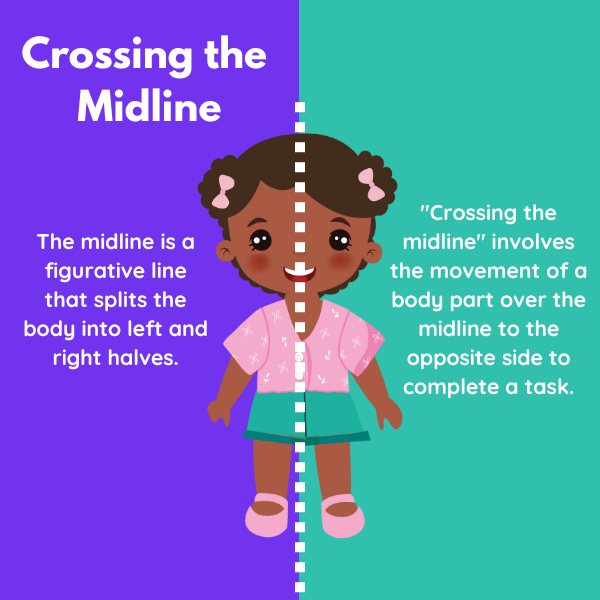Crossing the Midline: Part 1
What is crossing the midline and why is it important?
In the world of child development, crossing the midline is a pivotal skill that forms the foundation for various physical and cognitive abilities.
Crossing the midline refers to the ability to reach across and coordinate the body’s left and right sides, particularly with the hands and arms, in a smooth and coordinated manner. The “midline” is an imaginary line that divides the body into left and right halves. Mastering this skill is crucial for various physical and cognitive activities, including fine motor tasks, hand-eye coordination, and cognitive functions.
 Activities that involve crossing the midline stimulate both hemispheres of the brain and support the development of motor and cognitive skills, laying the foundation for more complex movements and tasks as a child grows.
Activities that involve crossing the midline stimulate both hemispheres of the brain and support the development of motor and cognitive skills, laying the foundation for more complex movements and tasks as a child grows.
Crossing the midline is an essential skill for children, as it plays a crucial role in their overall development. Here are several reasons why it is important for kids to master the ability to cross the midline:
- Bilateral Coordination:
- Crossing the midline promotes bilateral coordination, which is the ability to use both sides of the body together in a coordinated way. This is vital for activities that involve both hands and arms, such as writing, cutting, and tying shoelaces.
- Fine Motor Development:
- The ability to cross the midline is closely linked to fine motor development. It enhances hand-eye coordination and facilitates the refinement of fine motor skills needed for tasks like buttoning, zipping, and using utensils.
- Cognitive Skills:
- Crossing the midline stimulates both hemispheres of the brain, fostering improved communication between the left and right sides. This has positive effects on cognitive functions, including attention, problem-solving, and spatial awareness.
- Reading Readiness:
- The ability to track from left to right across a page, a fundamental skill in reading, is closely connected to crossing the midline. Children who struggle with crossing the midline may experience difficulties in acquiring reading readiness skills.
- Handedness Development:
- Crossing the midline can influence the development of handedness, helping children establish a dominant hand for activities. This is an important aspect of motor planning and organization.
- Sensory Integration:
- Midline activities contribute to sensory integration, helping children process and respond to sensory information effectively. This is especially beneficial for children with sensory processing challenges.
- Physical Milestones:
- Many physical milestones, from crawling to playing sports, involve the ability to cross the midline. Mastering this skill supports the progression of physical abilities as children grow.
- Spatial Awareness:
- Crossing the midline enhances spatial awareness, allowing children to navigate and understand their physical environment more effectively.
- Social and Play Skills:
- Engaging in activities that involve crossing the midline promotes cooperative play and social interactions. It encourages teamwork and coordination during group activities.
- Overall Coordination:
- A well-developed ability to cross the midline contributes to overall body coordination. It enables children to move smoothly and efficiently in various physical activities.


